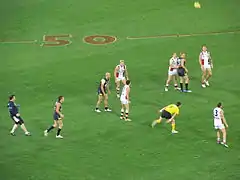Ball-up
A ball-up (pl. ball-ups) in Australian rules football describes a method of restarting play at a neutral contest after a stoppage within the field of play.[1] It is not to be confused with a boundary throw-in which occurs in most cases when the ball is forced out of bounds. Ball-ups may be considered to be the equivalent of a jump ball, faceoff or dropped-ball. Historically they were performed in most cases by a field umpire throwing the ball firmly into the ground such that it bounces directly upwards several metres into the air. They are also known as bouncedowns.

The Australian Football League amended the rules prior to the 2013 season to instruct the umpires to only bounce the ball at the start of each quarter and after a goal is scored, and throw the ball vertically upwards at all other times.[2] Previously throw-ups were only used if ground conditions did not allow for the ball to be bounced effectively, or after a bounced ball-up is poorly executed and recalled (skewing in such a way that only one of the competing ruckmen is able to contest the ball). The skill of being able to bounce an oblong shaped ball vertically upwards on a grass surface is unique to Australian Football and the difficulty has been blamed for deterring some from becoming umpires.[3]
The ball-up executed in the centre circle at the beginning of each quarter and after each goal is known specifically as the centre bounce. Centre bounces are contested by one nominated ruckman from each team, who attempts to direct the ball to a teammate.
Ball-ups can also occur at other locations around the ground. Umpires often have to decide whether a player tackled while in possession of the ball had a prior opportunity to pass the ball before they were tackled; if so, they will pay a free kick for holding the ball. If there was no such opportunity, then the umpire will call for a ball-up. Ball-ups are also frequently called when players from both teams scramble for a loose ball and neither can clearly secure possession. Before 2017, ball-ups which were not centre bounces, other players were allowed to help their ruckman in the contest by unexpectedly entering the contest and becoming the third man up. This was banned in 2017.
From 1907 until 2018, a ball-up is also called if the player executing a kick-in stepped outside the goal square before kicking the ball back into play following a behind.[4] In these cases, the ball-up was called at the top of the goal square. This rule was removed in 2019, replaced with the automatic calling of play on.[5]
References
- "Introduction to Aussie Rules Football". USAFL.
- "AFL keeps interchange uncapped for 2013". ABC. 16 October 2012.
- Blake, Martin (1 May 2003). "A bid to beat bouncedown yips". The Age.
- "Victorian Football League – a Football Squabble". The Age. Melbourne, VIC. 16 April 1907. p. 16.
- Ryan, Peter (11 October 2018). "Kick-in rules to change as 18-metre goal square idea discarded". The Age. Fairfax Media. Retrieved 21 January 2019.